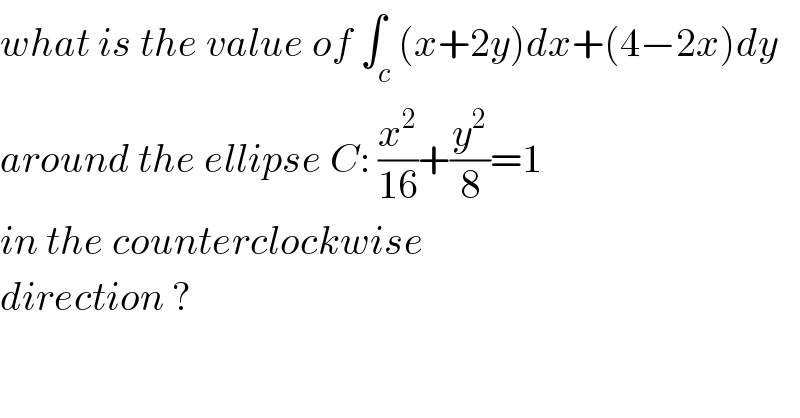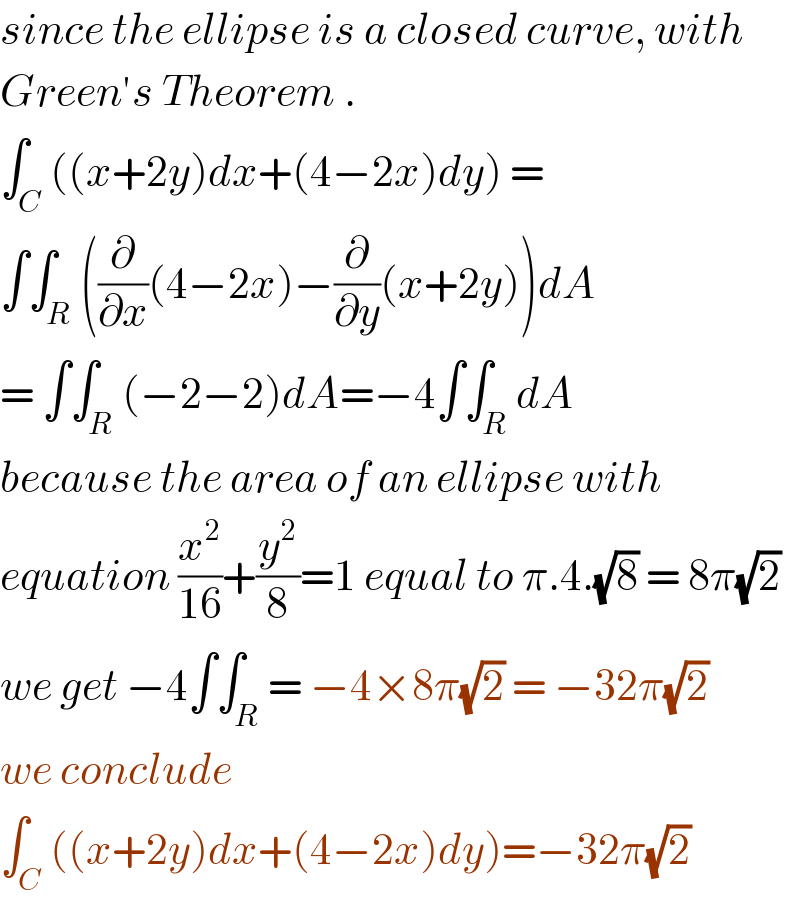
Question Number 103607 by bemath last updated on 16/Jul/20

$${what}\:{is}\:{the}\:{value}\:{of}\:\int_{{c}} \left({x}+\mathrm{2}{y}\right){dx}+\left(\mathrm{4}−\mathrm{2}{x}\right){dy} \\ $$$${around}\:{the}\:{ellipse}\:{C}:\:\frac{{x}^{\mathrm{2}} }{\mathrm{16}}+\frac{{y}^{\mathrm{2}} }{\mathrm{8}}=\mathrm{1} \\ $$$${in}\:{the}\:{counterclockwise} \\ $$$${direction}\:?\: \\ $$
Answered by bobhans last updated on 16/Jul/20

$${since}\:{the}\:{ellipse}\:{is}\:{a}\:{closed}\:{curve},\:{with} \\ $$$${Green}'{s}\:{Theorem}\:. \\ $$$$\int_{{C}} \left(\left({x}+\mathrm{2}{y}\right){dx}+\left(\mathrm{4}−\mathrm{2}{x}\right){dy}\right)\:= \\ $$$$\int\int_{{R}} \left(\frac{\partial}{\partial{x}}\left(\mathrm{4}−\mathrm{2}{x}\right)−\frac{\partial}{\partial{y}}\left({x}+\mathrm{2}{y}\right)\right){dA} \\ $$$$=\:\int\int_{{R}} \left(−\mathrm{2}−\mathrm{2}\right){dA}=−\mathrm{4}\int\int_{{R}} {dA} \\ $$$${because}\:{the}\:{area}\:{of}\:{an}\:{ellipse}\:{with} \\ $$$${equation}\:\frac{{x}^{\mathrm{2}} }{\mathrm{16}}+\frac{{y}^{\mathrm{2}} }{\mathrm{8}}=\mathrm{1}\:{equal}\:{to}\:\pi.\mathrm{4}.\sqrt{\mathrm{8}}\:=\:\mathrm{8}\pi\sqrt{\mathrm{2}} \\ $$$${we}\:{get}\:−\mathrm{4}\int\int_{{R}} =\:−\mathrm{4}×\mathrm{8}\pi\sqrt{\mathrm{2}}\:=\:−\mathrm{32}\pi\sqrt{\mathrm{2}}\: \\ $$$${we}\:{conclude} \\ $$$$\int_{{C}} \left(\left({x}+\mathrm{2}{y}\right){dx}+\left(\mathrm{4}−\mathrm{2}{x}\right){dy}\right)=−\mathrm{32}\pi\sqrt{\mathrm{2}} \\ $$
